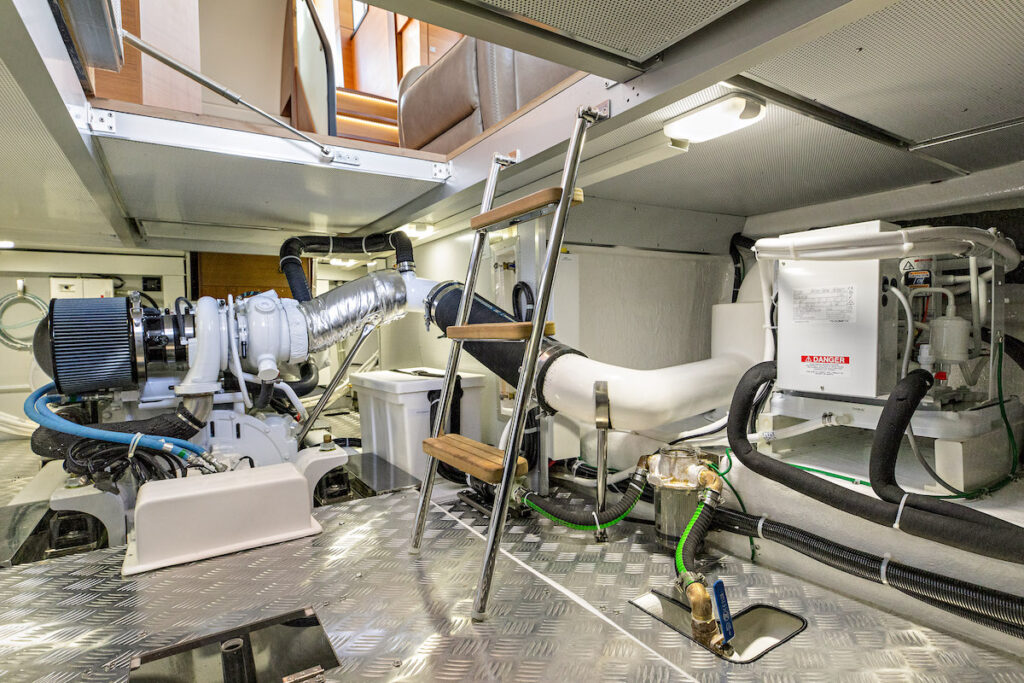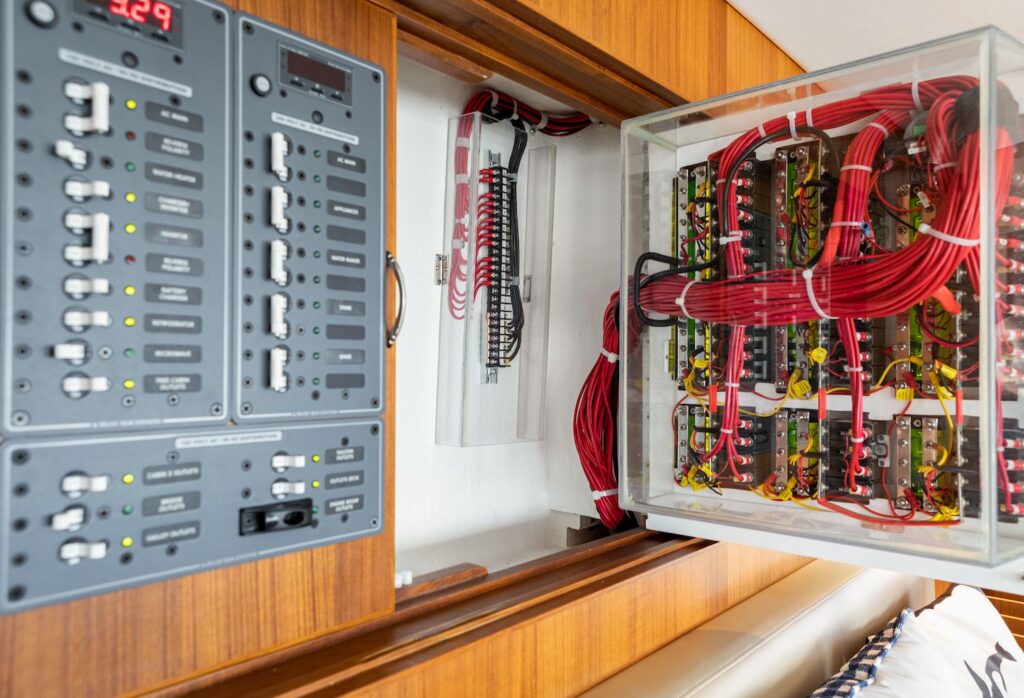Keeping a yacht in peak condition requires a proactive maintenance approach that ensures performance, safety, and longevity. At North Pacific Yachts, we emphasize the importance of routine inspections and scheduled servicing to prevent minor issues from escalating into costly repairs. Essential tasks include monitoring the hull for stress cracks or marine growth, inspecting electrical systems for corrosion or loose connections, and keeping mechanical components such as engines, fuel systems, and hydraulics in optimal working order. Regular maintenance also extends to onboard systems like plumbing, air conditioning, and navigation electronics, all of which play a crucial role in a yacht’s reliability at sea. Ensuring that bilge pumps, battery banks, and shore power connections are functioning properly helps prevent unexpected failures that could disrupt a voyage.
A well-maintained yacht is not only more reliable but also retains its value over time. Owners should adhere to a structured checklist that includes seasonal preparations such as winterization and pre-season inspections, as well as ongoing upkeep like deck refinishing, lubrication of moving parts, and antifouling applications. Mooring lines, safety equipment, and emergency systems must be checked regularly to ensure they meet operational standards. Implementing a detailed maintenance log allows for better tracking of completed tasks and upcoming service needs, helping owners stay ahead of potential issues. By following a thorough maintenance plan, yacht owners can enjoy smooth sailing, reduced downtime, and enhanced onboard comfort, whether for short excursions or extended bluewater cruising.
Routine Yacht Inspections for Preventative Maintenance
A well-maintained yacht requires routine inspections and consistent preventative maintenance to ensure safety, efficiency, and longevity. Regularly checking critical components helps identify and resolve issues before they become costly repairs, keeping the vessel in optimal condition.
Daily and Pre-Departure Checks
Before setting sail, inspecting fuel levels and checking for leaks in the fuel system is essential for safe operation. Navigation lights, gauges, and electrical panels should be tested to confirm proper function. A visual assessment of the hull can help detect stress cracks or fouling, which, if left unchecked, may lead to performance inefficiencies. Engine oil and coolant levels should be verified before starting, ensuring smooth operation and preventing overheating. Lastly, ensuring all safety gear, including life jackets and fire extinguishers, is onboard and accessible enhances preparedness for any unforeseen situations.
Weekly Yacht Maintenance Tasks
Weekly inspections help maintain functionality and prevent gradual wear. Deck fittings, including winches and cleats, should be cleaned and inspected for corrosion or mechanical wear. Battery charge levels must be checked, with terminals cleaned to prevent corrosion and ensure strong connections. If operating in saltwater environments, flushing the engine cooling system with fresh water prevents salt buildup that could impact engine performance. Running the generator under load helps prevent carbon buildup and ensures it remains in good working condition. Steering linkages and other moving mechanical components should be lubricated regularly to reduce friction and extend service life.
Monthly Maintenance Essentials
Monthly maintenance addresses deeper system checks. Bilge pumps should be inspected and tested to ensure they activate correctly when needed. The hydraulic system should be checked for pressure inconsistencies and potential leaks. Teak decks require cleaning and treatment to prevent mold, discoloration, and UV damage. Propeller shafts should be greased and examined for excessive wear to prevent vibration and efficiency loss. A thorough inspection of the electrical system, including wiring and grounding points, ensures safe and consistent power distribution.
Hull and Deck Maintenance: Preventing Wear and Corrosion
The hull and deck require continuous care to prevent long-term damage and preserve structural integrity. Regular cleaning and inspections keep these areas in prime condition.
Cleaning and Protecting the Hull
Routine hull washing is necessary to prevent marine growth accumulation, which can increase drag and reduce fuel efficiency. Applying protective wax or coatings helps maintain the gelcoat’s integrity and protects against UV damage. Antifouling paint should be inspected regularly, with reapplication scheduled as needed to prevent marine organisms from attaching to the hull. Fiberglass yachts should be checked for hull blistering or osmosis, which can compromise structural strength.
Deck and Exterior Care
Non-skid surfaces must be cleaned and inspected for wear, as deterioration can impact safety on deck. Metal fixtures and fittings should be treated with corrosion inhibitors to prevent rust and deterioration. Hatches, seals, and caulking should be examined for leaks or material breakdown to ensure water resistance. Stainless steel railings and fixtures require regular polishing to prevent pitting and surface degradation.
Keel and Rudder Inspections
The keel should be inspected for signs of grounding damage or structural separation. Rudder alignment must be checked, and bearings should be lubricated to ensure smooth steering. Hydraulic systems and steering cables should also be monitored to maintain reliable control over the vessel.
Engine and Propulsion System Maintenance
A well-maintained engine and propulsion system are key to ensuring reliable performance and fuel efficiency. Regular checks help prevent engine failure and costly repairs.
Routine Engine Inspections
Monitoring oil levels and scheduling routine oil and filter changes ensures smooth operation and longevity. Belts, hoses, and cooling system components should be examined for wear, as damaged parts can lead to overheating or power loss. Fuel injectors must be tested, and fuel filters replaced to maintain efficiency. Exhaust systems should be checked for leaks and excessive smoke, which can indicate potential engine issues.
Propeller and Shaft Care
Propellers should be inspected for dings, cracks, or bent blades, as damage can reduce fuel efficiency and increase vibration. Shaft bearings require greasing, and alignment should be checked to prevent excessive wear and imbalance. Removing barnacles and marine growth from the propeller enhances propulsion efficiency and reduces strain on the engine.
Fuel System Inspections
Fuel lines and connectors should be inspected for leaks, cracks, or deterioration. Water separators must be drained, and fuel filters replaced regularly to prevent contaminants from affecting engine performance. Periodic fuel tank cleaning removes sediment buildup that could cause clogs or injector damage, ensuring a steady fuel supply for smooth operation.

Electrical System Checks and Battery Management
A yacht’s electrical system must be regularly inspected and maintained to ensure safe and efficient operation. Electrical failures can lead to costly repairs and impact onboard systems, making routine checks essential.
Testing Yacht Batteries
Battery performance is a critical aspect of yacht maintenance. Voltage levels should be checked to ensure batteries hold a charge, and terminals must be inspected for corrosion, with connections cleaned as needed. Load testing batteries helps confirm their performance and prevents failures at sea. It’s also important to verify that battery chargers and inverters function correctly to maintain consistent power supply.
Electrical Wiring and Panel Inspections
Wiring systems must be examined for wear, corrosion, or overheating, as damaged wiring can cause power interruptions or fire hazards. Circuit breakers and fuses should be tested to ensure they are operational and capable of protecting electrical systems from surges. Shore power connections require inspection to confirm they are secure and free from corrosion, while the bonding system and grounding points should be checked for continuity to prevent electrical faults and corrosion.
Plumbing and Water System Maintenance
Proper maintenance of the yacht’s plumbing and water systems ensures a reliable freshwater supply and efficient waste management. Regular inspections help prevent leaks, clogs, and component failures.
Freshwater System Care
Freshwater tanks should be flushed and sanitized periodically to prevent contamination. Water pumps need to be checked for consistent pressure and potential leaks. Hoses and connections should be inspected for wear or looseness, and filters must be cleaned or replaced to ensure clean water circulation throughout the vessel.
Greywater and Blackwater System Maintenance
Holding tanks must be emptied and treated with proper chemicals to prevent odor buildup and blockages. Macerator pumps should be checked for clogs or mechanical failures, and discharge valves and seacocks must be tested for leaks or obstructions. Greywater tanks should be cleaned and deodorized regularly to maintain hygiene standards onboard.
Bilge Pump and Drainage System Checks
Bilge pumps play a vital role in removing excess water from the yacht. Automatic and manual bilge pumps should be tested for reliable operation, and any debris in pump intakes should be cleared to prevent clogging. Float switches must function correctly to prevent flooding, and bilge areas should remain dry and free from oil contamination to avoid damage to internal systems.
Navigation and Safety Equipment Inspections
Yacht navigation and safety systems must be checked frequently to ensure operational readiness. Malfunctioning equipment can compromise safety, particularly during long voyages.
Navigation Electronics and Instrumentation
GPS, radar, and chartplotter accuracy should be verified to ensure reliable navigation. VHF radio functionality must be checked, and distress signals tested to confirm emergency readiness. Software and firmware for navigation systems should be updated regularly, and depth sounders and autopilot systems should be calibrated for optimal performance.
Life-Saving and Emergency Gear
Life rafts should be inspected, and hydrostatic release units checked for operational readiness. The expiration dates of flares, EPIRBs, and fire extinguishers must be verified to ensure compliance with safety regulations. Emergency lighting should be tested, and spare batteries kept onboard. Anchors and mooring lines must be examined for wear or fraying to ensure secure docking and emergency anchoring capability.
Seasonal and Long-Term Maintenance Planning
Comprehensive seasonal maintenance planning helps extend the yacht’s lifespan and ensures it remains in peak condition throughout the year.
Pre-Season Preparation
Before launching for the season, a thorough inspection should be conducted to check for any issues that developed during storage. All mechanical and electrical systems must be tested before extended voyages. Necessary coatings and treatments should be applied to protect against environmental exposure, and spare parts and essential maintenance tools should be stocked for offshore travel.
Winterization and Off-Season Storage
Draining and winterizing plumbing systems prevent freezing damage. Engines should be protected with antifreeze and fogging oil before storage to avoid mechanical issues. Batteries must be removed and stored in a controlled environment to maintain longevity. The yacht should be covered or shrink-wrapped to protect it from weathering and UV exposure during extended periods of non-use.
Keeping a Maintenance Log for Performance Tracking
Maintaining records of inspections, repairs, and part replacements helps yacht owners stay ahead of potential issues. Maintenance should be scheduled based on usage patterns and manufacturer recommendations. Using digital logs enhances organization and provides easy access to historical data for tracking recurring maintenance needs. A well-documented maintenance history also improves resale value and simplifies insurance claims by providing a detailed record of upkeep.

Contact Us
At North Pacific Yachts, we’re here to make your journey to owning the perfect yacht seamless and enjoyable. Whether you’re looking for expert guidance on model specifications, insights into custom build options, or simply need a few questions answered, our team is ready to assist. With years of experience in yacht building, we’re dedicated to understanding your unique vision and helping you navigate the entire process with ease. Reach out to us by email at info@northpacificyachts.com for personalized responses to all your inquiries.
If you’d prefer a conversation, we invite you to give us a call at 1-877-564-9989. Speaking directly with our experienced team can provide immediate answers and professional insights into everything from specific build features to delivery timelines. At North Pacific Yachts, your satisfaction is our top priority, and we’re here to ensure you’re confident and informed at every step of your yacht ownership journey.
See our models here:
Related Posts
Essential Yacht Maintenance Tips for Every Season
The Ultimate Guide to Yacht Engine Maintenance


